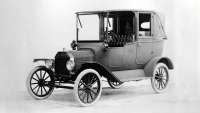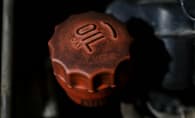You hear the term all the time, but what is a muscle car?
To be honest, there’s no hard and fast definition. Just as a coupe can be either a two-door or four-door car depending on your point of view, different enthusiasts will describe the muscle car concept differently, and there’s a range of debatable points on offer.
And while we tend to think of old American muscle cars first and foremost, Australia has a rich muscle car history, too.
But, if we can break it down to a simple one or two sentence description, it would probably be along the lines of: A factory modified version of a production car with the aim of increasing performance, attitude and desirability. And with an emphasis on straight-line acceleration over any other dynamic element.
The performance and attitude things speak for themselves, but the desirability aspect is critical, too, because the ultimate aim of the muscle car was to give the whole contents of a carmaker’s showroom a leg-up.
It was never lost on car manufacturers that many people wandered in to a showroom to look at the lime-green muscle car and drove home in the white station wagon.
In may cases, the muscle car would be based on that production sedan or coupe, but fitted with a bigger engine from elsewhere in the manufacturer’s catalogue.
.jpg)
Whack on some wider wheels and rubber, add some stripes and maybe even a spoiler or two, stiffen the suspension, improve the brakes and bolt a tachometer into the interior and you had yourself a muscle car.
In some cases, of course, carmakers could be pretty cynical organisations, and many was the car that was treated to the stripes and bucket seats, but boasted no actual performance improvements. These weren’t muscle cars at all and not everybody was fooled.
There was one other major reason for a factory muscle car; racing homologation. In many forms of racing over the years, carmakers have been required to produce a minimum number of examples before the car would be allowed to race.
.jpg)
In this case, manufacturers really ramped things up – particularly in the USA – where production cars suddenly sprouted horsepower in multiples of 100, huge wings and spoilers, wide tyres, specific braking , suspension packages and even cold-air intake systems to help with performance.
These days, it’s probably these American homologation specials (like the wildly magnificent Dodge Daytona and Plymouth Superbird twins) that are the most prized and valuable muscle cars.
The official muscle car history lesson probably starts involving the masses in the mid-1960s when two cars hit showrooms almost simultaneously. The Plymouth Barracuda was first with its fastback styling and V8 engine, but the Ford Mustang that followed just a couple of weeks later was the car that set the whole thing in motion.
.jpg)
Of course, what people tend to forget was that even though there was no 1950s Mustang or Barracuda, there was a car called the Hudson Hornet which in 1951 launched with a unique step-down chassis for a lower centre of gravity, a huge 5.0-litre, inline six-cylinder engine and the speed to dominate stock car racing in the day.
So, was the Hudson Hornet the first true muscle car? Many think it was. Certainly, it helped mould the accepted muscle car definition with its racing pedigree and factory-performance credentials.
Of course, it’s the 1960s muscle cars we remember best. But, to be honest, that original Mustang was only a fringe-dweller in the world of muscle cars and was marketed as a personal coupe with the option of a six-cylinder engine and three-speed automatic if you wanted the look without the purchase price.
.jpg)
But once Ford had figured out that the compact Mustang could be (over)powered with ever-bigger V8 engines and even raced in the domestic Trans Am series, the die was cast.
And before you knew it, the other mainstream US carmakers had their own muscle cars on sale including legends like the Chevrolet Camaro (the Corvette is more of a sports car – if you take the Chevy marketing bumpff at face value) Dodge’s Super Bee, Charger and Challenger and even the American Motors AMX Javelin to name just a handful.
By the time the 1960s was coming to and end, so was the first wave of muscle cars as tougher emissions and safety laws in the USA were becoming too hard to get around.
.jpg)
In the end, the mighty Mustang was reduced to a four-cylinder compact-car layout. Meanwhile, even the race-homologation cars became victims of their own success with motor sport authorities banning the wildest of them in order to keep Nascar’s oval-track speeds below 200 mile-per-hour (320km/h).
And without a race series to compete in, there was no longer any point in building them. And that was pretty much that.
Around the same time as the American muscle car was being hobbled, the major Australian carmakers were discovering the potential in the same concept. Enter the Holden Monaro and Torana, the Ford Falcon GT and the Valiant Pacer and Charger as the best muscle cars Australia ever produced.
These are now the cars that represent the most collectible, most valuable Aussie cars ever made and while you could buy non-muscled-up versions with mild drivelines and column-shifted automatics, the real muscle-car versions with big V8 engines, tuned six-cylinders and manual gearboxes were tremendous cars.
They looked the part, too, with mad stripes, two-door coupe bodies, fat wheels and tyres and lots of wings, spoilers, cold-air intakes and big exhausts.
Even though Australia’s muscle car culture mirrored the USA’s to a large extent, other countries were in on the act, too. Most recently, things like the Mercedes-AMG C63 and E63 sedans could fairly be called muscle cars. Even the original Porsche 911 Turbo (also known as the 930) could be argued on to the list of alternative muscle cars.
And that’s the point, really. A muscle car doesn’t necessarily need a V8 engine to comply with the blueprint. As long as it’s a manufacturer’s own take on a car that reduces the time between corners and offers that king-of-the-road demeanour (as well as being careful not to stray into grand-tourer or sports-car territory) then it’s a chance to be called a muscle car.
As far as the hard-liners are concerned, the 1970s muscle cars were dim shadows of their former outrageous selves. And the deeper into the '70s you got, the worse it became with ever-tougher smog laws and safety campaigns watering down the muscle car concept.
By the 1980s muscle cars were mostly memories with one real exception. And that car was the Buick Grand National. By taking its family-wheels Regal, Buick added a turbocharger to the 3.8-litre V6 engine and, in a stroke created a car that could out accelerate the then-current model Porsche 911 and plenty of others.
With all black paint and detailing, the Buick even looked half tough and the final iteration, the GNX of 1987, with an intercooler and even bigger turbocharger was a true performance car in a very muscular way.
So, what are muscle cars doing in the current century? Well, it’s fair to say the muscle car is back, of course – and how - with things like the Mustang Dark Horse, Chevrolet Camaro ZL1 and the Dodge Challenger Hellcat all leading a reboot of the muscle car theme.
It’s interesting, too, that the muscle car brands back in the day are the ones being touted in 2025. Clearly, retro plus muscle is a powerful combination of forces.





.jpg)
.jpg)


.jpg)

.jpg)

.jpg)



.jpg)
.jpg)
.jpg)
.jpg)
.jpg)
.jpg)
.jpg)
.jpg)
.jpg)

.jpg)
.jpg)
.jpg)

.jpg)
.jpg)
.jpg)
.jpg)
.jpg)
.jpg)
.jpg)
.jpg)
.jpg)
.jpg)
.jpg)
.jpg)
.jpg)
_0.jpg)
.jpg)
.jpg)




